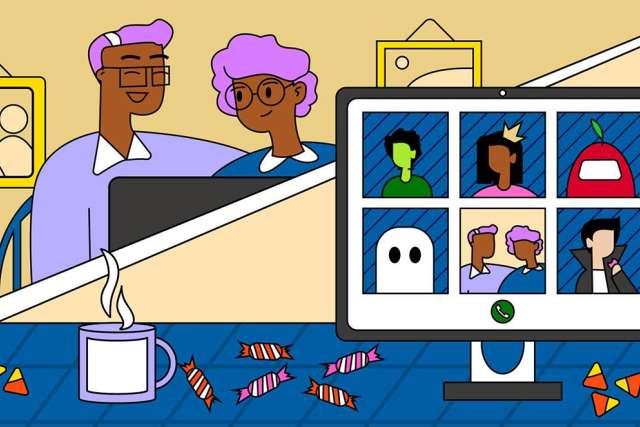Halloween during a pandemic looks so different from years past, it’s scary.
Los Angeles County public health officials have nixed the usual parties, carnivals and parades even if they are conducted outdoors. They also say one of the holiday’s most beloved traditions — trick-or-treating — is not recommended because of the risk of improper masking and the difficulty of maintaining “proper social distancing on porches and at front doors.”
Beyond the county's guidance, cities may enact further restrictions: For instance, Beverly Hills has banned trick-or-treating outright.
So what are families of would-be ghouls and goblins to do? Find creative ways to make Halloween special just as they did for graduation celebrations earlier this year, says Jena Lee, MD, assistant professor of psychiatry at the David Geffen School of Medicine at UCLA.
“When you look back at annual Halloweens, we tend to celebrate it in the same way,” she says. “But imagine having Halloween at home and the entire family is inside the home. …I really encourage families to take these challenges as opportunities to make things really, really special.”
Helping your children process their feelings
In a year characterized by loss for kids — no classroom learning, no playground fun, no summer camp — missing out on trick-or-treating can feel like one more disappointment on a growing list. It’s important for parents to acknowledge the loss and validate children’s feelings, Dr. Lee says. She suggests initiating a conversation with young ones to find out why they think trick-or-treating isn’t happening this year.
“It might be because of the virus. It might be because the news said so. It might be because Daddy said so,” she says of the answers parents may hear. “You want to meet your child where they are by engaging them and by asking open-ended questions so you can get where their focus is.”
Parents can then share that they feel disappointed by all the changes, too, Dr. Lee says.
Allow children some time to process their feelings, then brainstorm together to come up with alternative activities. Parents don’t need to act like they have all the answers, she says. It can be more comforting for kids to know that this is uncharted territory for everyone — they learn as much by watching the adults around them as they do by hearing what those grown-ups say.
“Kids are very sensitive to the anxiety level and assurance level of their parents,” Dr. Lee says. “They gauge how worried their parents are by the parents’ behavior. That modeling is so important in children’s development and how they’re learning to deal with setbacks.”
Families that work together to come up with solutions to challenges “are the ones that are doing markedly better” than those that get stuck on the losses or insist on problem-solving without children’s input, she says, adding that it comes down to modeling positive perspective.
“There are so many ways to make this time special, and it’s not about what the best solution is,” she says. “It’s about the attitude and excitement that parents can bring in for their kids and the kids will feed off of that.”
How to still celebrate Halloween
While parents and children may be disappointed to miss trick-or-treating and costume parties, they can lift their spirits together by getting excited about new ways to celebrate.
Decorating face coverings with Halloween stickers and other craft supplies is one way to encourage both safety and whimsy, says Annabelle de St Maurice, MD, MPH, co-chief infection prevention officer for UCLA Health. “You can get in the mood of Halloween without putting yourself at risk.”
Video-conferenced costume contests or watching Halloween movies with friends over Zoom are other pandemic-safe ideas. L.A. County health guidance also suggests car parades, online pumpkin-carving contests and Halloween movie nights at drive-in theaters.
“There are some unique things you can do to try and have your children and family members have a fun experience since it’s just such a part of tradition in America,” Dr. de St Maurice says.
Risks of trick-or-treating
County health officials have stopped short of putting an outright ban on trick-or-treating, but “it’s not recommended,” says Dr. de St Maurice. “Because when you’re showing up to somebody’s house, you don’t know if they’re going to be wearing a mask or if they’re going to be doing hand hygiene appropriately.”
And if unexpected trick-or-treaters come to the door?
“It kind of boils down to your comfort level,” she says. “But certainly if they’re not wearing a mask that seems like it would be protective — and since they’re not following L.A. County Public Health recommendations — I think that it could potentially be a bit higher risk.”
The city of Beverly Hills has gone so far as to ban residents from passing out treats to anyone outside their immediate household — and it’s possible more cities may follow their example in the days leading up to Halloween.
Residents of areas without such a ban who still want to pass out treats might consider leaving a bowl of pre-packaged candy on the doorstep, then washing the vessel with soap and water afterward, Dr. de St Maurice says. Candy packaging doesn’t have to be sanitized, she says, but after the wrapper is opened and discarded, it’s important to wash the hands before eating.
Parents can use holiday sweets as a teaching moment for little ones, she says: “This is a great opportunity for children to learn to clean their hands before they have snacks or treats.”



